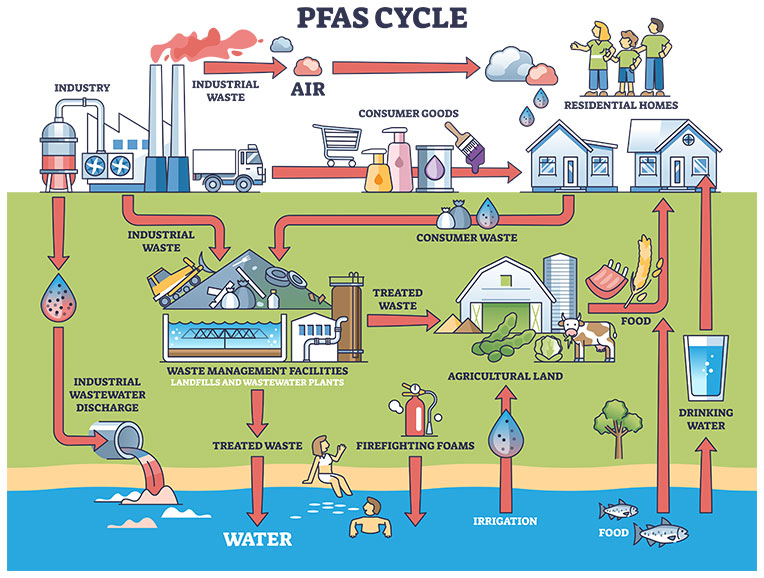By Erin Brockovicxh
We talk about PFAS chemicals a lot in this newsletter and for good reason, but today I want to discuss 1,4 dioxane, a major contaminant found in our drinking water from coast to coast.
This synthetic solvent is used in a variety of industrial and manufacturing settings and is also known as a forever chemical because it lingers in the environment and can be very difficult to remove.
Millions in the U.S. have been exposed to this chemical in their drinking water, and they have no idea. What’s worse: we have no studies about the impact of this chemical to humans that consume it.
Since the 1950s, 1,4-dioxane has been used as a stabilizer in industrial solvents. U.S. production dropped dramatically after ‘90s. Even after the last several manufacturers stopped production, companies continued to import it for industrial use. Because of prior use and disposal, it still contaminates many landfills and Superfund sites across the country.
Additionally, it’s found in many personal care products, including shampoo, body wash, bubble bath, foaming hand soap, cosmetics, deodorant, and skin lotion — and is often found in laundry detergent, dishwashing soap, and household cleaners.
Florida: Tainted Tap Water
One of our readers posted a recent story about this cancer-linked chemical causing trouble in Central Florida.
It started more than half a century ago beneath a telecommunications factory in Lake Mary, Florida, when the chemical started spreading for miles through the Floridan Aquifer and seeping into water wells serving thousands of Seminole County residents, according to reporting in the Orlando Sentinel.
Now the Florida Geological Survey has publicly verified the contamination’s fingerprint, path, and pointed to the responsible polluters.
Surprise, surprise, industrial giants are to blame! In this case, owners of the defunct factory which include General Dynamics Corp., Siemens Corp., and a company that holds financial assets of a previous factory tenant, MONI Holding LLC.
The state DEP has billed the three companies $1.4 million for the state’s recent probing into the factory pollution—investigative work the department had unsuccessfully sought to have the companies perform in 2023.
“It can safely be assumed that, from 1968 to the present, the facility has been releasing contaminants,” states a December memorandum from the top leaders of the Florida Geological Survey.
I will say this until I am blue in the face because I teach my grandchildren this lesson all the time. You must clean up after your own mess.
I’m not foolish enough to think that we don’t enjoy a certain standard of life thanks to business and industry. We need jobs and commerce, so I’m not suggesting we turn away from it all.
Businesses need to stop this dump-and-run model. They can’t destroy the water we all need to live and pretend nothing is wrong. We need purpose-driven corporations that are willing to clean up their toxic remnants and to work with communities. They already have the funds to make things right because they all employ huge legal departments to fight these environmental claims.
Huge Problem Everywhere
Of course, this chemical is not just a Florida problem. I’ve been talking about 1,4 dioxane for years. Not only is it an irritant but it is classified by numerous regulatory bodies as either a probable or known carcinogen. The U.S. Department of Health and Human Services considers 1,4-dioxane as reasonably anticipated to be a human carcinogen. U.S. EPA calls it a “likely human carcinogen” that has been found in groundwater at sites throughout the country.
But 1,4-dioxane, like thousands of other potentially dangerous chemicals, is unregulated and has not been assigned a legal limit in drinking water.
Earlier this year, extremely high levels of 1,4-dioxane were discovered in Asheboro, North Carolina’s wastewater discharge, according to the N.C. Department of Environmental Quality. Initials tests revealed it at 2,200 ppb, and the city’s own testing showed it at 3,520 ppb.
No Federal Standard
These figures are up to 10,000 times above the recommended number.
California, Colorado, New York, Massachusetts, North Carolina … and nearly every state across the country has this contaminant in their drinking water, but there is no federal standard to regulate it in tap water.
The U.S. EPA has said 0.35 parts per billion (ppb) of 1,4-dioxane in water is the amount expected to cause no more than one additional case of cancer in every million people who drink it for a lifetime. But how can communities protect themselves when most have no idea this chemical even exists?
Some states have set their own limits but just look at the differences.
- California water utilities must notify state regulators if 1,4-dioxane is detected above 1 ppb. It is recommended that consumers are notified if there are exceedances.
- Colorado’s standard for 1,4-dioxane in groundwater is 0.35 ppb.
- Connecticut’s action level for 1,4-dioxane in drinking water is 3 ppb.
- Maine’s non-enforceable drinking water guideline for 1,4-dioxane is 4 ppb.
- Massachusetts’ non-enforceable drinking water guideline for 1,4-dioxane is 0.3 ppb.
- Michigan’s clean-up standard for 1,4-dioxane in groundwater is 7.2 ppb.
- Minnesota’s non-enforceable drinking water guideline for 1,4-dioxane is 1 ppb.
- New Hampshire water utilities must report 1,4-dioxane at levels of 0.25 ppb and above.
- New Jersey’s groundwater quality standard is 0.4 ppb for 1,4-dioxane.
- New York set a first in the nation enforceable maximum contaminant limit of 1 ppb for 1,4 dioxane in drinking water. New York also finalized limits on levels in household cleaners and personal care products not to exceed 1 part per million.
- North Carolina’s groundwater quality and surface water supply standards for 1,4-dioxane are 3 ppb and 0.35 ppb, respectively.
Most in-home water filters, including activated carbon filters, don’t remove 1,4-dioxane effectively.
Reverse osmosis filters are better, removing a significant portion of the chemical from tap water, but still fall short.
That means that people in communities that get their drinking water from groundwater contaminated with 1,4-dioxane should urge their local utilities to install specialized technology, the only effective way to remove the chemical.
Beyond that, communities need to push for better federal oversight to stop the chemical from getting into the water supply in the first place. We need to advocate for more science to study its impact on human lives.
In Florida, this matter became widely known thanks to local reporting, when the Sentinel published a series of stories titled “Toxic Secret.”
Our country has lost more than one-third of its newspapers since 2005, according to a 2024 Medill report. The loss of local newspapers is continuing at an alarming pace, deepening the local news crisis and further depriving people of information they need to make informed decisions.
News deserts, or counties without any locally based source of local news, are on the rise. More than half of the nation’s 3,143 counties have little to no local news.
I know there’s a lot of talk about bias in media lately, but I think it’s important to consider how local news keeps people informed about these toxic issues. Don’t forget that media can be a powerful tool in spreading awareness about pollution. Check out an article at cnet.com called “When Local Newspapers Fold, Polarization Rises” to learn more about solutions to local journalism deficits.
Unaffordable Eggs
A new report from Food & Water Watch details how Big Ag is cashing in on a crisis.
Since 2022, avian influenza H5N1, or bird flu, has spread to poultry and egg hens across the country, impacting dairy herds and farmworkers as well as million-bird flocks. And while it has slightly reduced U.S. egg production, corporate greed has also played a major role in higher prices.
Egg prices have fluctuated wildly since the first infection of bird flu outbreak was detected in commercial flocks in February 2022. However, a deep dive into corporate filings and U.S. Department of Agriculture data suggests that corporations may have used the outbreak as a smokescreen for raising prices beyond what was necessary to cover any rising costs.
This research shows how egg corporation have pushed prices way higher than growing costs, leading to record profits.
Worse, factory farms, where Cal-Maine and other corporations raise up to a million or more chickens in crowded conditions, are hotbeds for disease. Under the status quo, the factory farm model could create the next pandemic.
Cal-Maine produces more than 1 in 5 of the eggs eaten in the U.S. and is the country’s leading egg producer. It owns 43 egg production facilities, which stuff an average of 1 million hens into each operation.
It’s also one of the few publicly traded egg corporations, which means some of its financial data is public.
Food & Water Watch looked at the company’s reports to the Securities Exchange Commission and USDA data on egg production and bird flu, finding that despite narratives blaming bird flu shortages for price hikes, Cal-Maine factory farms remained free of bird flu until December 2023. In fact, during the company’s fiscal year 2023, June 2022 through May 2023, it sold 7% more eggs compared to FY 2021. That same year, its profits soared more than seven-fold.
Cal-Maine is not alone in profiting from catastrophes. Across the food system, from seeds to supermarkets, corporations are taking advantage of crises to pocket more profits. How can they get away with it? Highly concentrated industries empower them.
We need to enforce our nation’s antitrust laws to go after corporate price fixing. We also need a national ban on new and expanding factory farms, and fair wages and healthcare access for workers.
Policies like the Farm System Reform Act and the Price Gouging Prevention Act can stop rising food prices and tackle bird flu at the same time.
•••
Read the full report about unaffordable eggs at https://tinyurl.com/RottenEggOligarchy. Learn more about fighting factory farms at https://tinyurl.com/fighting-factory-farms.




